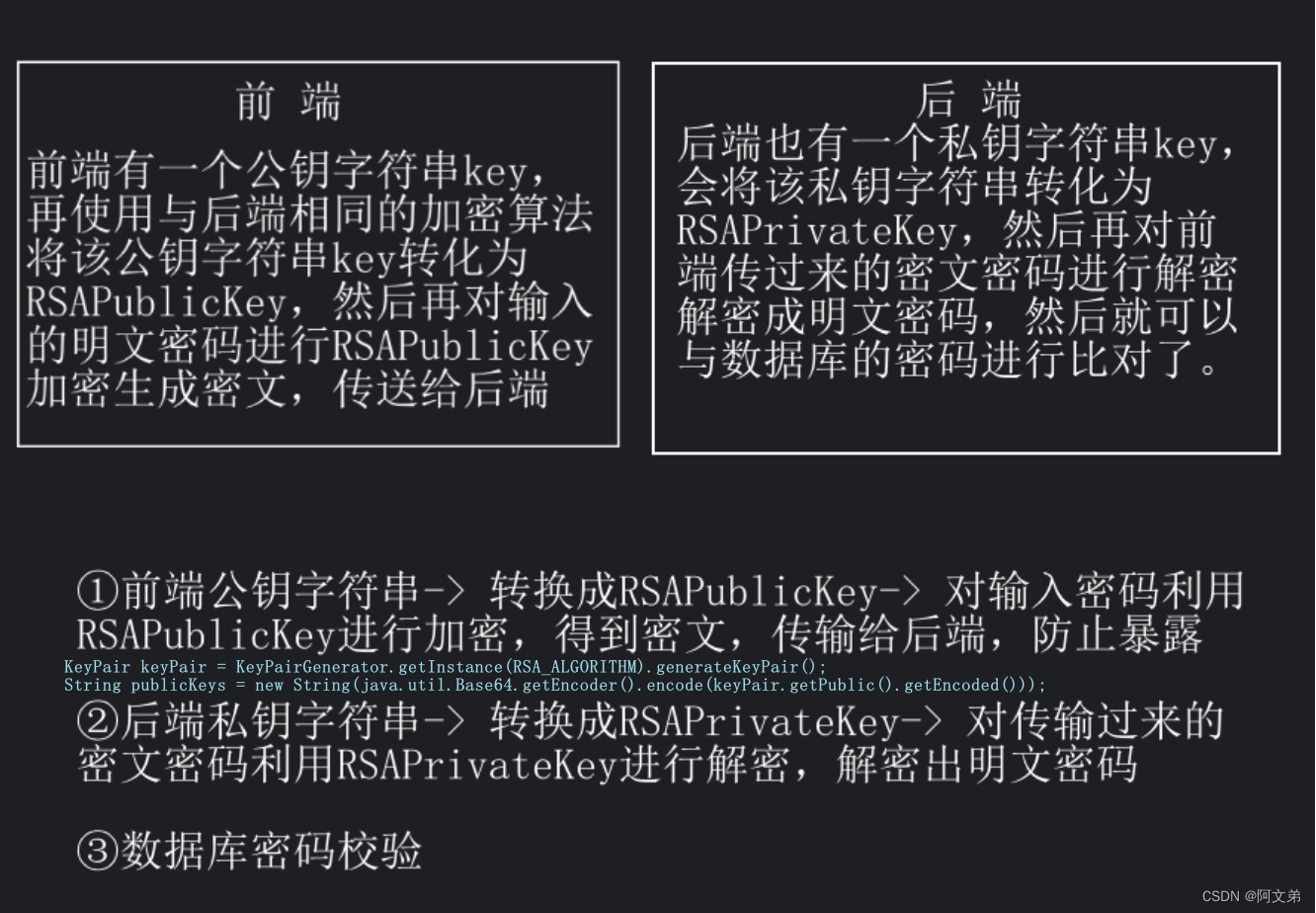/** @description: 将普通的publicKey转化得到一个RSAPublicKey* @author: zkw* @date: 2024/1/24 16:17* @param: publicKey 普通的publicKey* @return: RSAPublicKey 得到一个新的RSAPublicKey**/public static RSAPublicKey getPublicKey(String publicKey) throws NoSuchAlgorithmException, InvalidKeySpecException {//通过X509编码的Key指令获得公钥对象KeyFactory keyFactory = KeyFactory.getInstance(RSA_ALGORITHM);X509EncodedKeySpec x509KeySpec = new X509EncodedKeySpec(Base64.decodeBase64(publicKey));RSAPublicKey key = (RSAPublicKey) keyFactory.generatePublic(x509KeySpec);return key;}/** @description: 将明文字符串利用RSAPublicKey公钥加密成一个密文* @author: zkw* @date: 2024/1/24 16:24* @param: data 待加密的明文字符串* @param: publicKey RSAPublicKey* @return: String 密文字符串**/public static String publicEncrypt(String data, RSAPublicKey publicKey) {try {Cipher cipher = Cipher.getInstance(RSA_ALGORITHM);cipher.init(Cipher.ENCRYPT_MODE, publicKey);return Base64.encodeBase64URLSafeString(rsaSplitCodec(cipher, Cipher.ENCRYPT_MODE, data.getBytes(CHARSET), publicKey.getModulus().bitLength()));} catch (Exception e) {throw new RuntimeException("error......", e);}}/** @description: 将普通的privateKey转化得到一个RSAPrivateKey* @author: zkw* @date: 2024/1/24 16:41* @param: privateKey 普通的privateKey* @return: RSAPrivateKey 得到一个新的RSAPrivateKey**/public static RSAPrivateKey getPrivateKey(String privateKey) {// 通过PKCS#8编码的Key指令获得私钥对象KeyFactory keyFactory;RSAPrivateKey rsaPrivateKey;try {keyFactory = KeyFactory.getInstance(RSA_ALGORITHM);PKCS8EncodedKeySpec pkcs8KeySpec = new PKCS8EncodedKeySpec(Base64.decodeBase64(privateKey));rsaPrivateKey = (RSAPrivateKey) keyFactory.generatePrivate(pkcs8KeySpec);} catch (Exception e) {throw new ServiceException(Codes.PASSWORD_DECRYPTION_EXCEPTION);}return rsaPrivateKey;}/** @description: 将密文使用私钥进行解密 解密出明文* @author: zkw* @date: 2024/1/24 16:42* @param: cipherText 密文* @param: privateKey RSAPrivateKey私钥* @return: String 明文**/private static String privateDecrypt(String cipherText, RSAPrivateKey privateKey) {try {Cipher cipher = Cipher.getInstance(RSA_ALGORITHM);cipher.init(Cipher.DECRYPT_MODE, privateKey);return new String(rsaSplitCodec(cipher, Cipher.DECRYPT_MODE, Base64.decodeBase64(cipherText), privateKey.getModulus().bitLength()), CHARSET);} catch (Exception e) {throw new ServiceException(Codes.PASSWORD_DECRYPTION_EXCEPTION);}}rsaSplitCodec()方法
private static byte[] rsaSplitCodec(Cipher cipher, int opmode, byte[] datas, int keySize) {int maxBlock = 0;if (opmode == Cipher.DECRYPT_MODE) {maxBlock = keySize / 8;} else {maxBlock = keySize / 8 - 11;}ByteArrayOutputStream out = new ByteArrayOutputStream();int offSet = 0;byte[] buff;int i = 0;try {while (datas.length > offSet) {if (datas.length - offSet > maxBlock) {buff = cipher.doFinal(datas, offSet, maxBlock);} else {buff = cipher.doFinal(datas, offSet, datas.length - offSet);}out.write(buff, 0, buff.length);i++;offSet = i * maxBlock;}} catch (Exception e) {e.printStackTrace();}byte[] resultDatas = out.toByteArray();IOUtils.closeQuietly(out);return resultDatas;}四个方法我直接贴出来,两个方法是关于公钥的,两个方法是关于私钥的
我们写一个测试方法,看看明文加密之后的密文,在经过解密后的明文是否一致。
public static void method(String clearPassword) throws NoSuchAlgorithmException, InvalidKeySpecException {//【前端通过js】 1、生成一个普通的PublicKey,一般这里前端会生成,同时也需要转化成一个RSAPublicKey,然后再对输入的明文字符串进行加密成一个密文,这里我不知道前端怎么写,我们就以后端的思路去代替KeyPair keyPair = KeyPairGenerator.getInstance(RSA_ALGORITHM).generateKeyPair();String publicKey = new String(java.util.Base64.getEncoder().encode(keyPair.getPublic().getEncoded()));RSAPublicKey rsaPublicKey = getPublicKey(publicKey);String cipherText = publicEncrypt(clearPassword, rsaPublicKey);//密文字符串//【后端通过代码】2、生成一个普通的PrivateKeyString privateKey = new String(java.util.Base64.getEncoder().encode(keyPair.getPrivate().getEncoded()));// //3、将普通的privateKey转化为一个新的RSAPrivateKeyRSAPrivateKey rsaPrivateKey = getPrivateKey(privateKey);
//
// //4、对前端传过来的密文利用RSA私钥进行解密String res = privateDecrypt(cipherText, rsaPrivateKey);System.out.println("加密之前的明文:" + clearPassword);System.out.println("加密之后的密文:" + cipherText);System.out.println("================================");System.out.println("解密之后的明文:" + res);}运行结果:

所以以后在登录的时候呢,前端会对界面输入的明文密码进行公钥加密成密文密码,然后再传给后端,后端就会利用私钥进行解密解密出明文密码,然后与数据库的进行比较。
总结:
使用java.security包下的api进行密码的加密传输(公加私解)
给大家画个流程图:

最后:
如果大家觉得这篇文章对大家有所帮助的话,希望能给个免费的赞赞,也祝各位码农在未来的IT道路上能越走越远。谢谢。











)






安装keepalived和haproxy)
